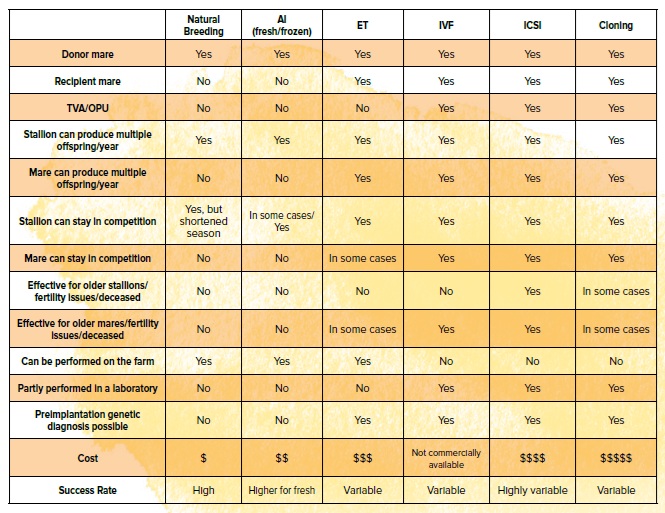Equine Assisted Reproductive Techniques (ART)
Assisted reproductive techniques (ART) can aid in breeding and improve reproductive outcomes.
Artificial Insemination (AI) is the introduction of fresh, cooled, or frozen semen into the mare’s reproductive tract without natural mating. It is the oldest and most widely used ART in the horse to expand stallion genetics without transporting animals for mating. Although easier and less invasive than other methods, AI requires careful timing of insemination with ovulation and management of mares after breeding. This is especially critical when frozen semen is used since its longevity is significantly shorter than fresh or cooled semen.
This is the least expensive ART option. The success rate is high, particularly with fresh and cooled semen.
Embryo Transfer (ET) is the collection of an embryo from a donor mare and transfer into a recipient mare (surrogate). This involves synchronizing the reproductive cycles of both mares and breeding the donor mare, usually with AI. Genetic testing can be performed on the embryo to determine sex and genetic traits prior to transfer (pre-implantation genetic diagnosis).
Several pregnancies can be produced in a season from an elite donor mare without significantly affecting training or competition. Embryos are flushed 7 to 8 days after ovulation and the donor mare can be bred in a few days to generate additional embryos.
Success rates vary, but ET is generally reliable for fertile mares. Costs are moderate to high. The limited availability of recipient mares presents challenges.
In Vitro Embryo Production (IVEP) is the process of producing and culturing embryos in a laboratory until they reach a stage of development where they can be transferred to a recipient or frozen for future transfer.
Oocytes are collected by transvaginal oocyte aspiration (TVA, also known as ovum pickup (OPU)) directly from the ovaries of a standing mare under sedation.
In Vitro Fertilization (IVF)
For IVF, oocytes are matured, fertilized with sperm in a laboratory, and cultured for 7 - 9 days. The resulting embryos may undergo genetic testing and are implanted into a recipient or frozen for storage.
Although common in humans and livestock species such as cattle, IVF has had little success in horses. Equine embryo production has been achieved, but only using high-quality, fresh sperm, which limits its use. The UC Davis Veterinary Assisted Reproduction
(VetART) Laboratory recently reported using frozen-thawed sperm to fertilize equine oocytes and create embryos (Martin-Pelaez et al., 2024). Further research is in progress.
This process is labor-intensive and costly. Success rates vary based on sperm quality. While some sires yield good results, others produce poor outcomes.
Intracytoplasmic Sperm Injection (ICSI)
This is a specialized form of IVEP in which a single sperm is injected directly into an oocyte. The fertilized egg is cultured, and the embryo is implanted into a recipient mare.
This approach has become widely used in horses. It can help overcome male fertility issues such as poor sperm quality or low motility. It is also an important technique to preserve the genetics of deceased stallions or those with limited semen availability (Malin et al. 2024).
ICSI allows the use of sex-sorted semen, a newly available option that enables deliberate selection of the sex of the offspring. Recently, the VetART laboratory reported the first use of frozen sexed semen for ICSI in horses (Dini et al., 2023).
Costs for ICSI are high and success is highly variable.
Cloning
Somatic cell nuclear transfer (SCNT) cloning produces a foal that is genetically identical to the donor. The nucleus of a body (somatic) cell from the donor is removed and transferred into an egg cell that has had its nucleus removed. The egg cell with the donor nucleus develops into an embryo, which is transferred into a mare.
Cloning is commercially available in horses, and hundreds of cloned equids have been produced.
Cloning efficiency is low, and large numbers of oocytes are required, limiting availability. Costs are high.
Applications
Assisted reproductive techniques can ensure that top-performing horses pass on their superior traits to future generations. It is important to select the appropriate method for the goals of the breeding program. Some procedures are expensive and technical and may not be feasible or available to all breeders. Success rates are variable, and efforts may not result in pregnancies or live births.
The use of ART may be regulated differently by country or region, potentially creating barriers for international breeding programs. Also, some breed organizations, such as the Jockey Club, may not register horses produced through ART.
For more information about equine ART, visit the VetART Laboratory.
Table. Comparison of ART techniques in horses.

